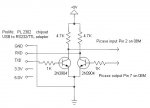My USB to RS232 adapter died recently, and I had a couple of cheap single board adapters around that I intended to build into projects, to make Picaxe reprogramming with a USB cable easy.
Cost of the adapter, called a USB to RS232 TTL 232 Converter Module PL2303 Chip PC was $5.69 USD each, with free shipping from China, at Markmart.com
It includes jumper wires to connect to a header, on board 5 and 3.3 volt power and LEDs to indicate power, receive, and transmit.
The adapters used the same Prolific PL 2303 chipset I've been using all along - so no need for a new driver and it is compatible with my ordinary USB to RS232 adapter.
BUT they invert the signal... Using the com port "test" in the programming editor the input to the axe is "low" when the on screen light is "on" and visa versa (or backwards). The "terminal" however, worked fine when I shorted the transmit and receive pins on the module, so I knew it was working or would work if the polarity was reversed.
I wired a couple of 2N3904 inverters to invert the signals and it works like a champ.
Cost of the adapter, called a USB to RS232 TTL 232 Converter Module PL2303 Chip PC was $5.69 USD each, with free shipping from China, at Markmart.com
It includes jumper wires to connect to a header, on board 5 and 3.3 volt power and LEDs to indicate power, receive, and transmit.
The adapters used the same Prolific PL 2303 chipset I've been using all along - so no need for a new driver and it is compatible with my ordinary USB to RS232 adapter.
BUT they invert the signal... Using the com port "test" in the programming editor the input to the axe is "low" when the on screen light is "on" and visa versa (or backwards). The "terminal" however, worked fine when I shorted the transmit and receive pins on the module, so I knew it was working or would work if the polarity was reversed.
I wired a couple of 2N3904 inverters to invert the signals and it works like a champ.
Attachments
-
21.1 KB Views: 141

